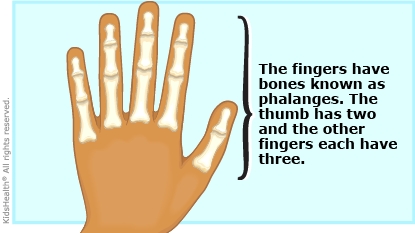Broken Finger: How to Care for Your Child
A broken finger means one or more of the finger bones has a fracture or crack. A splint or buddy tape (using tape to hold the injured finger to a neighboring finger) keeps the broken bone from moving while it heals. Taking good care of the splint or tape and treating pain will help keep your child comfortable while healing.


To decrease swelling:
-
Prop up the hand on pillows when your child is sitting down or sleeping.
-
If your child was given a sling, use it as directed. Don't use the sling during sleep.
-
Remind your child to wiggle the uninjured fingers to keep blood circulating normally.
If your child has pain:
-
When your child is awake, put ice in a plastic bag wrapped in a towel on the broken finger for 20 minutes every 3 hours for up to 2 days. Don't put ice directly on the skin.
-
Use these medicines exactly as directed:
-
acetaminophen (such as Tylenol® or a store brand)OR
-
ibuprofen (such as Advil®, Motrin® or a store brand). Don't give to babies under 6 months old.
Daily care if your child has a splint:
-
Don't remove or change the position of the splint unless the health care provider said it's OK.
-
Check the area around the splint. Make sure the skin isn't scratched and the fingers aren't pale, blue, numb or tingling.
-
Make sure your child doesn't pick or scratch under the splint.
-
Don't put anything in the splint. For example, make sure your child doesn't put toys, food or other objects into it.
-
Keep dirt, sand, lotion and powder away from the splint.
-
Keep the splint dry:
-
Put a plastic covering over the splint when your child bathes.
-
If the splint is accidentally splashed, gently blow air onto it from a hair dryer on the cool setting.
Daily care if your child has tape:
-
If you don't see dirt on the skin, your child should use hand sanitizer instead of washing hands with soap and water.
-
Replace the tape as you were taught if it gets wet or dirty.
-
Keep cotton or gauze between the buddy-taped fingers to protect the skin.
-
Loosen the tape if it feels too tight.

-
Pain doesn't improve with medicine.
-
Blisters, rashes or raw spots appear on the skin around the splint or tape.
-
A foul smell or drainage comes from the splint or tape.
-
Your child gets a fever while the finger is healing.

-
The splint feels too tight or your child's fingers are pale, cold, numb or tingly.
-
Your child has a splint and it cracks, becomes loose, gets wet or falls off.

How long will it take a broken finger to heal? Most broken fingers are better in a couple of weeks. Your child will have one or more follow-up visits with a health care provider who specializes in the care of bones. During these follow-ups, the health care provider will check to make sure the finger is healing well.
When can my child return to sports? The health care provider will tell you when it's OK for your child to return to sports. Your child may need to wear protective hand gear or taping during sports for a few weeks or possibly longer.